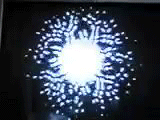Video feedback


of optical feedback
Optical feedback is the optical equivalent of acoustic feedback. The feedback occurs when a loop exists between an optical input, for example, a videocamera and a television screen or monitor. (A simple example of optical feedback is an image cast between mirrors.)
In this GIF movie, and the JPG still image examples (right), light from a candle is received by a videocamera, amplified and then sent by cable to a monitor projecting electron beams on the inside of the monitor screen. The image on the monitor is then captured by the videocamera again, and fed back to the monitor in a continuous loop.
The original light source, in this case from the candle, can then be extinguished, while the feedback loop continues. For each loop the image is doubled and the image interferes with itself. The electronic loop moves with near light speed, but as the resulting image is projected onto the phosphor dots on the inside of the screen the speed is stopped for as long as allowed by the time the phosphor points glow, and thus creating a "queue" of illuminated dots on the screen.
The resulting images depend on different camera and monitor settings, such as light amplification, contrast, distance, angle and physical vibrations. Optical feedback can be combined with music, or other sound sources, to influence the image loop.
In entertainment
Many artists have used optical feedback. An example is Queen's music video for Bohemian Rhapsody. The effect (in this simple case) can be compared to looking at oneself between two mirrors.
The opening titles sequence for the British sci-fi series Doctor Who employed this technique from 1963 to 1973 (black-and-white initially, redone from 1967, then redone again, in colour this time, from 1970).
In science
The optical feedback discussed so far—video feedback, created by a camera pointing at its own monitor—is actually just one particular example of optical feedback. Perhaps the most obvious example of optical feedback in science is the optical cavity found in almost every laser, which consists of two curved mirrors facing each other. In the late 1990s it was found that so-called unstable cavity lasers in fact produce beams that are fractal shaped (Link to original article in Nature Vol. 402, 138 (11 November 1999)).
Optical feedback in science is often closely related to video feedback, so an understanding of video feedback is often very useful for other applications of optical feedback. Video feedback has, for example, been used to explain the fractal structure in laser beams.
Video feedback is also useful as an experimental-mathematics tool. Examples of its use include the creation of Fractal patterns using multiple monitors or multiple images created using mirrors.
The page video feedback in science provides an overview.
Softology's Video Feedback page provides links and information about real and simulated video feedback.
In philosophy
Douglas Hofstadter uses a direct analogy to Optical feedback (Video feedback) in his book I Am a Strange Loop about the human mind and consciousness.
